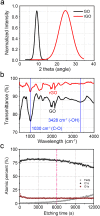Water Lubrication of Stainless Steel using Reduced Graphene Oxide Coating
- PMID: 26593645
- PMCID: PMC4655472
- DOI: 10.1038/srep17034
Water Lubrication of Stainless Steel using Reduced Graphene Oxide Coating
Abstract
Lubrication of mechanical systems using water instead of conventional oil lubricants is extremely attractive from the view of resource conservation and environmental protection. However, insufficient film thickness of water due to low viscosity and chemical reaction of water with metallic materials have been a great obstacle in utilization of water as an effective lubricant. Herein, the friction between a 440 C stainless steel (SS) ball and a 440 C stainless steel (SS) plate in water lubrication could be reduced by as much as 6-times by coating the ball with reduced graphene oxide (rGO). The friction coefficient with rGO coated ball in water lubrication was comparable to the value obtained with the uncoated ball in oil lubrication. Moreover, the wear rate of the SS plate slid against the rGO coated ball in water lubrication was 3-times lower than that of the SS plate slid against the uncoated ball in oil lubrication. These results clearly demonstrated that water can be effectively utilized as a lubricant instead of oil to lower the friction and wear of SS components by coating one side with rGO. Implementation of this technology in mechanical systems is expected to aid in significant reduction of environmental pollution caused by the extensive use of oil lubricants.
Figures





References
-
- Wang Q. J. & Chung Y.-W. in Encyclopedia of Tribology 3816–3818 (Springer, 2013).
-
- Ding Q. et al. Improved tribological behavior of DLC films under water lubrication by surface texturing. Tribol. Lett. 41, 439–449 (2011).
-
- Chen C.-Y. et al. Low-friction characteristics of nanostructured surfaces on silicon carbide for water-lubricated seals. Tribol. Lett. 51, 127–133 (2013).
-
- Wang Q. et al. Influence of Ti content on the structure and tribological properties of Ti-DLC coatings in water lubrication. Diam. Relat. Mater. 25, 163–175 (2012).
-
- Wang Q. et al. Influence of carbon content on the microstructure and tribological properties of TiN(C) coatings in water lubrication. Surf. Coat. Technol. 206, 3777–3787 (2012).
Publication types
LinkOut - more resources
Full Text Sources
Other Literature Sources

